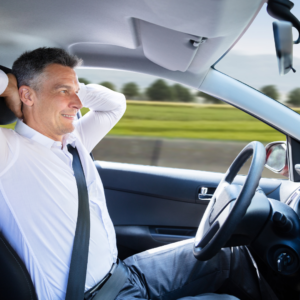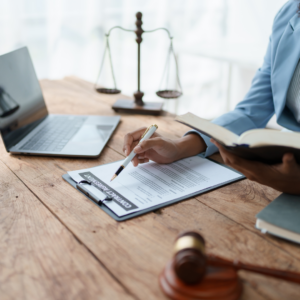 Self-driving cars are here, with companies like Tesla, Waymo, and Uber leading the charge. But as these high-tech vehicles become more common, one big question remains: who’s responsible if something goes wrong? Is it the car’s software, the human driver, the manufacturer, or even the government?
Self-driving cars are here, with companies like Tesla, Waymo, and Uber leading the charge. But as these high-tech vehicles become more common, one big question remains: who’s responsible if something goes wrong? Is it the car’s software, the human driver, the manufacturer, or even the government?
With self-driving technology designed to make roads safer, there are still plenty of unknowns when it comes to accidents.If you’ve been involved in a self-driving car crash, figuring out who’s at fault can feel overwhelming. Don’t worry; we’re here to break it all down and help you understand this new reality.
Before we get into who’s responsible for a self-driving car accident, it’s important to understand how these vehicles work and why liability isn’t always clear-cut. With human drivers, determining fault was straightforward. But with self-driving cars, things get tricky. These vehicles rely on complex algorithms, sensors, and AI to make decisions, so who’s to blame when something goes wrong? Is it the software, the human operator, the manufacturer, or someone else? Let’s dive in and break it down.
Self-driving cars use advanced tech like sensors, radar, cameras, and AI to operate without human help. The idea is that by removing human error—the main cause of traffic accidents — these cars could make the roads safer. But as we’ve seen in some high-profile crashes, the technology isn’t foolproof. Even though it’s getting better, self-driving cars can still make mistakes. For example, if a car’s sensors fail to spot a pedestrian or obstacle, it could be responsible for the accident.
Determining liability in self-driving car accidents isn’t as simple as it might seem. In traditional accidents, liability is often placed on the driver—if they were distracted, speeding, or failed to follow traffic laws. However, in the case of autonomous vehicles, liability becomes a much more complex question.
One reason for this complexity is that self-driving cars are designed to make decisions without human input. If the car’s AI makes an error, who should be held accountable? Is it the manufacturer who created the vehicle, the software developer who created the algorithms, or the human driver who should have been monitoring the vehicle? And what if the accident is caused by a defect in the vehicle’s hardware or software?
Self-driving cars are classified into six levels of automation, ranging from Level 0 (no automation) to Level 5 (full automation). The levels of automation help determine who is responsible for the vehicle’s operation at any given moment.
The level of automation at play in a particular accident plays a significant role in determining who is responsible. In higher levels of automation, liability may rest more on the manufacturer or software developer, while lower levels still place responsibility on the human driver.
Now that we’ve explored the complexity of autonomous vehicles, let’s look at the key players who could be held liable in the event of a self-driving car accident.
In some cases, the driver of the self-driving car can still be held responsible for an accident. This is especially true when the car is not operating at full autonomy (i.e., the vehicle is in Levels 2 or 3). In these levels, the driver is required to remain attentive and ready to take control of the car if necessary.
In many cases, the vehicle manufacturer may be held responsible for a self-driving car accident. This is particularly true if the accident was caused by a defect in the car’s hardware or software.
The algorithms and software that power autonomous vehicles play a critical role in their performance. If a software error or bug causes a crash, the software developer could be held responsible.
If the accident involves a self-driving car operated by a company like Uber or Lyft, the company could be held liable. This is particularly true when the accident occurs in a commercial setting, such as a self-driving taxi or delivery service.
In some cases, the government or local road authorities could be partially responsible for a self-driving car accident. This usually occurs when poor road conditions or inadequate traffic signals contribute to the crash.
 Product Liability vs. Driver Negligence: Key Legal Considerations
Product Liability vs. Driver Negligence: Key Legal ConsiderationsWhen it comes to legal action after a self-driving car accident, the question of whether a manufacturing defect or driver negligence causes the issue is important. If the crash is caused by a defect in the vehicle’s software or hardware, a product liability claim may be in order.
However, if the accident is caused by the driver failing to take control of the vehicle when necessary, it may be a case of driver negligence. The legal complexities in these cases are significant, and having the right legal team by your side can make all the difference.
Insurance policies for self-driving cars are still evolving, and there are many challenges when it comes to determining coverage and liability. Traditional auto insurance policies may not fully account for the complexities of autonomous vehicles. As self-driving cars become more prevalent, we can expect new insurance models to emerge that are specifically designed to address these challenges.
If you’re involved in a self-driving car accident, it’s paramount to take the right steps to protect your rights:
If you’ve been involved in a self-driving car accident, don’t hesitate to reach out to an experienced personal injury attorney. At Regan Zambri Long, we specialize in managing complex cases involving self-driving vehicles. Contact us today for a free consultation to discuss your legal options and get the support you need to recover and move forward.